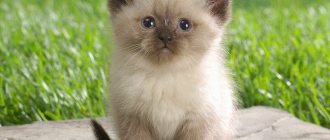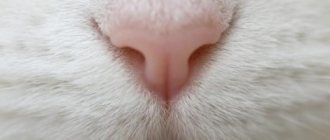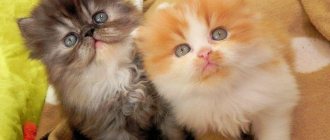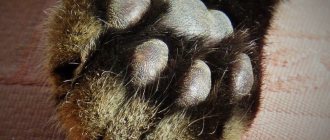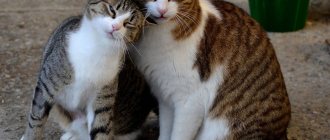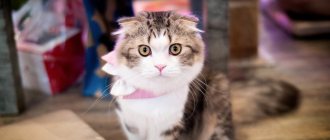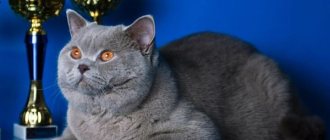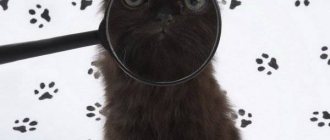Ginger cats and male cats can be of different colors and breeds. In nature, there are no monochromatic ginger cats; the color of the animal is always patterned or interspersed. It is believed that all red-haired representatives have a similar character.
There are several breeds of red cats: Maine Coon, red Persians, Karelian Bobtail, American Curl, Napoleon, Somali cat, Ural Rex, Caracal, Turkish Van, Siberian cat, red British.
Maine Coon
Red cats of the Maine Coon breed are one of the favorites of tailed cat lovers. Representatives of the breed are impressive in size, but retain playfulness, energy and mobility, remaining kittens at heart until old age.
Note: they get along well with people, are friendly, kind and affectionate, a great option for families with children. But they behave warily towards strangers.
Due to its resemblance to the raccoon and lynx, the cat was nicknamed the Maine coon cat. The Maine Coon can come in a variety of colors. Representatives of this cat breed mature within 4 years and can be born with polydactyly - a large number of fingers.
They prefer good premium food and the necessary care.
Red Persians
These fluffy beauties are considered a symbol of wealth and social significance. The breed stands out from the rest by the characteristic structure of its muzzle, on which the depressed nose is in line with the eyes. The pride of the Persian cat is its beautiful coat. Cats are characterized by calmness, balance and silence. They try not to let the owner out of sight at the same time, without annoying them with their meowing.
Representatives of the breed love to communicate with children and adults, walk, and ride public transport.
Note: Not the best breed for catching rodents.
Requires special attention: sometimes you need to wipe your eyes and put in drops; The wool needs to be brushed for 15-20 minutes a day. Representatives of this breed often experience breathing problems.
Fiery color and folk beliefs
From time immemorial, cats have been credited with magical properties. Many superstitions are associated with them, which have developed as a result of centuries-old observations. So, in the 21st century there are a huge number of people who do not follow the road if a black cat has crossed it. This is considered to be unlucky.
But regarding ginger cats, there is a popular opinion that they, on the contrary, bring happiness, good luck and prosperity to the house. It is believed that pets of this color represent light, sun, and warmth. If you keep an orange cat in your house, then adversity and bad luck will very rarely come home.
Many people notice that cats are excellent diagnosticians and healers. There are many stories about how these animals lie precisely on a person’s sore spot, and after their influence the owner feels much better. Many believe that it is the ginger cat that promotes a speedy recovery. He can relieve spasms and eliminate migraines.
Previously, they thought that a fire kitten was able to drive quarrels out of the house, establish mutual understanding between spouses, and ward off envy and damage from them. There is also an opinion that saffron milk caps attract material well-being (gold) into the home.
Did you know? Sometimes owners love their mustachioed pets so much that they are ready to give them their entire fortune. Blackie is considered the richest cat in the world, to whom her owner bequeathed 15 million pounds.
A number of signs are also associated with the behavior of a fire cat in the house. For example, if your pet greets your guest warily or threateningly, then most likely this person is up to something evil. If, upon your return home, “Murka” simply keeps up with you and asks to be held in your arms, then perhaps she feels negative energy from you, which she wants to remove. If a fiery handsome man crosses your path from left to right before a trip, then it is advisable to postpone the trip, or at least delay it for 15-20 minutes.
Karelian Bobtail
The Karelian-Finnish cat, or Karelian bobtail, is a rare breed of small-sized aboriginal Russian cats. It is distinguished by a pleasant character and a tail resembling a pom-pom measuring 4-13 cm. It was the tail that gave rise to the name of the breed with the word “bobtail”.
Karelian bobtails are affectionate, friendly, kind, sympathetic, and treat children's games and guests well. There is no importunity or rancor in them, and animals just don’t like to meow. Karelians get along well with all pets and love to catch rodents.
They have excellent health and do not require special care. In our country, this breed is almost impossible to find, as it is rare and on the verge of extinction.
Note: they are very touchy if they are pointedly offended.
American Curl
This breed was registered at the end of the twentieth century. A distinctive feature of Curls is their folded back ears. The bend of the ears can be 90-180 degrees.
Animals of this breed have excellent health and a wonderful disposition. She loves interacting with children and gets along well with other pets.
American Curls are prone to obesity, so you should carefully monitor their diet. They are easy to care for, so they are perfect as pets for single men.
Note: when cleaning curls' ears, do not bend or turn the ears in the opposite direction.
Napoleon
This breed got its name due to the small height and weight of the animal. Everyone knows that Napoleon was short. The color of this breed can be very diverse: red, peach, white, gray. There are two varieties of the breed: classic, with long legs, and extreme, with short legs.
Representatives of this breed are very peaceful and get along well with other pets. They require increased attention and often suffer from loneliness.
Note: Napoleons are very patient with small children and may well become their friend.
Color genetics: participants in the process
Only 2 pigments take part in the formation of the color of a cat’s fur - eumelanin (black) and pheomelanin (red). And 2 more structures (one from each parent) with 19 chromosomes each transmit hereditary instructions.
Inside 1 chromosome, more than 25 thousand genes are “encoded”, which form all the external characteristics of the animal - from height and weight to the length of fur and the color of kittens.
The X and Y chromosomes are responsible for the sex of the offspring. They always come in pairs, where XX creates a girl, and XY creates a boy. This is an important factor for ginger (red) cats. Their color depends on gender, since the O gene (orange, responsible for pigment) is attached only to the X chromosome. Therefore, ginger male cats are more common because they have fewer options in the combination of genes and chromosomes.
Each color gene exists in at least two alleles - dominant and recessive. For the color red, the first is designated as "O" and the second as "o". For white these are W and w, and for black there are three varieties: B, b and bl. The latter, when duplicated, gives a hint of cinnamon (cinnamon).
Depending on the set of genes, all cat colors are subject to strict rules. Chromosomes are instructions that are inherited from parents, they create an ordered structure and lay down the appearance characteristics in the offspring.
Somali cat
The richness of the colors is what amazes you when you first look at this breed. The red color takes on various shades - from light cream to deep red. The Somali cat is distinguished from other breeds by a light frill on the neck and black tips of the hair.
Animals are suitable for those people who are rarely at home because they can easily tolerate loneliness. But first, the kitten must be provided with a variety of toys, otherwise, out of boredom, it will spoil everything it gets into its teeth.
Somalis tolerate water well and love to swim and play in the water. Cats of this breed are very jealous, but treat other pets well. They love to move and hone their hunting skills.
The Somali cat does not need special care, only the oral cavity is susceptible to infection, so it is worth cleaning it regularly.
Genetics of color
It is simply unrealistic to obtain a tortoiseshell cat through targeted breeding work. Difficulties are caused by the inability to organize chaotically located chromosomes. Therefore, even a tortoiseshell cat produces kittens with red, snow-white or black fur.
The color and pattern of a fur coat are determined genetically long before the moment of birth. Mother cats have a set of a pair of chromosomes - XX, and males - XY. The peachy-red and black shade of the coat is carried by the X chromosome. This means that in addition to white fur, females may also develop orange and charcoal fur. But males with one X chromosome, in addition to snow-white, can be either red or black.
The charcoal and red shades of cat fur are determined by the genes of the sex chromosomes - X and Y. Moreover, the latter is smaller in size and does not carry genes for red (O) or black (o) color. Therefore, only the combination XO + Xo produces tortoiseshell coloring.
Ural rex
This is an aboriginal breed of cat, spotted in the Urals in the pre-war years. Its distinctive feature is its curly coat, which naturally forms into graceful curls. Curly-haired cats are few in number and not as popular as Persians or Maine Coons.
Ural rexes are smart, affectionate and silent, they love to spend time with children and adults, and sleep with their owners. They remain loyal to their owner, while calmly treating strangers.
Pets of this breed are distinguished by good health and do not require special care. Ural rexes are unpretentious eaters and can feed on foods of natural origin.
Color options
In fact, the red color is considered a mutation; a special Orange or O gene located on the X chromosome is responsible for it. For this reason, among kittens, ginger cats are most often found, not cats. This is a dominant mutation, due to which the body produces a special pigment, pheomelanin, which gives the coat a characteristic fiery hue.
Important! Each red fluffy cat is unique because the color is never solid. It usually forms fancy patterns, such as stripes, spots and various patterns
If the special recessive diluent d is present in the genome, the animal's coat will be cream. In other cases, when Orange is present on two X chromosomes, the kitten will be born with a tortoiseshell color. Since this gene is always located on a specific chromosome, taking into account the color, it is possible to predict the color of the coat that the kittens will have. Below are the most popular combinations:
- uniform reddish tint with light spots combined with copper eyes, dark orange nose and paw pads;
- creamy red color with lighter stripes or spots;
- rich bright red combined with dark “tiger” stripes;
- golden-reddish hue interspersed with white hairs and copper or gold-colored eyes;
- light red with ears, paws and tail tip of a darker shade.
White-red
The red-and-white fluffy cat is a representative of the most popular color, which is never uniform. More often there are kittens with a tricolor or brindle color, a dark back and a white belly.
To achieve the ideal color, professional breeders do not mix red and cream representatives of the breed; the result is kittens with perfectly fiery fur.
Black and red
Cats with black and red hair look unusual; they are more often found among representatives of mixed breeds.
Pedigree pets mainly have a tortoiseshell color, including black and reddish shades characteristic of a particular breed
Marbled multi-colored cats are very beautiful and instantly attract attention. Many people get such animals precisely because of their non-standard coat.
Gray-red
Beautiful gray-red cats and cats are also no less popular compared to their counterparts with fur of a uniform fiery shade. The most spectacular color combines red, gray and white shades; such cats are often found among non-pedigree cats, but at the same time they are no less loved by their owners.
Brown and red
The combination of brown and red is not too uncommon in color; such cats are found among Maine Coons and Persians with tortoiseshell hair.
A small brown-red kitten often turns into a unique specimen with a special, unique color and character.
Caracal
This is a wild cat breed that lives mainly in the deserts of Asia and Africa. Caracals are more adapted to living in natural conditions: they swim well and climb trees.
It is not recommended to keep this breed at home. Caracals are beautiful large predators with high immunity, so they rarely get sick. It is recommended to feed with protein foods: fish, meat, eggs.
Note: Caracals should not be fed pork.
Turkish van
Turkish cats are one of the oldest breeds, as confirmed by recent genetic studies. Their main feature is their love of bathing and swimming.
The coat of Turkish Vans is waterproof, soft to the touch, and has the ability to change depending on the habitat the cat is in. In summer, the coat becomes harsher and shorter than in winter.
This breed is also distinguished by its naturalness, naivety and tenderness.
Siberian cat
Back in the 16th-17th centuries, Siberian cats were found throughout almost the entire territory of the Russian Empire, including Siberia. The harsh climate with frosty winds and snow contributed to the appearance of long hair in animals, protecting them from the cold.
By nature, furry pets are friendly and affectionate. Animals of this breed love children, are sociable and neat. They get along well with pets, but do not tolerate rodents. Siberian cats are easy to care for: just brush them and add vitamins to their food.
Are there differences in character and behavior?
The genetic characteristics of the appearance of fluffy saffron milk caps affect the characteristics of their character. These are just assumptions, but supported by observations of the behavior of cats of this color. Thus, it is believed that the characteristic features of saffron milk caps are intelligence, audacity and independence. These cats are playful, active, playful and cunning. They love playing with children. There is an opinion among cat lovers that the brighter the color of an animal’s coat, the more difficult it is to get along with it under the same roof.
It is important for cat owners who care about the health of their pet to have information on how to determine if an animal has worms, and what should be done to avoid such a problem. It will also be useful for you to read about how to cure a cat from: lichen, subcutaneous mites, ear mites, fleas and lice.
All of the above features are not scientifically proven. But it is a fact that red cats are more susceptible to allergic diseases. Just like the fact that they tolerate anesthesia worse.
British cats
According to legend, the ancestor of the British was the Cheshire Cat. This breed is distinguished by its sensitivity and intelligence. British cats show independence in behavior and do not like to be held and can be aggressive. There are many color options and red is very common.
Note: British people can be alone for a long time.
Animals of this breed have a large build and good immunity. However, they are prone to obesity, so you need to make sure that your pet is actively moving and does not overeat.
Varieties
Tortoiseshell coloring is considered one of the most bizarre and difficult to reproduce. It happens:
- solid - with evenly distributed spots that do not form patterns;
- patterned - with distinct “marble veins”, stripes and spirals.
Depending on which of the three basic shades is predominant, the tortoiseshell color is divided into 3 varieties:
- Black tortoiseshell with a predominance of charcoal and red. Moreover, in places where there are red areas there are light stripes.
- Chocolate with a predominance of red and chocolate shades. Moreover, both pigments are evenly saturated.
- Cinnamon with a predominance of red and brown tones.
Depending on the shape, size and location of the colored spots, it is also divided into 3 varieties:
- torti (scaly);
- calico (patchwork);
- tortoiseshell with white.
Torti (scaly)
This coloring resembles small fish scales of black and red color. The charcoal and red areas overlap each other and have no clear boundaries. This color option is typical for representatives of the Persian and Siberian breeds, as well as yard cats.
Calico (patchwork)
This color is a combination of charcoal and tan and resembles a patchwork quilt. Pronounced pigmented areas are located in a chaotic manner and can overlap each other. The coloring of the Calico is characteristic of the Devon Rex, Scottish and British breeds.
Tortoiseshell with white
This color variant has distinct white spots mixed with a base color of red and charcoal. Moreover, the upper part of the body is covered with wool of a classic tortoiseshell color, and the white areas are localized in the lower part of the cat’s body.
Best articles: Can dogs eat tangerines?
